More information has come to hand since I wrote Large Anchors Found at Normanville and More About the Shipwrecks at Normanville.
Firstly, I accidentally found a copy of a letter written by David Muirhead’s father in 1970 on my computer. David’s father, David R. Muirhead, described the recovered anchor in the letter to the Regional Controller for the Department of Shipping at Port Adelaide.
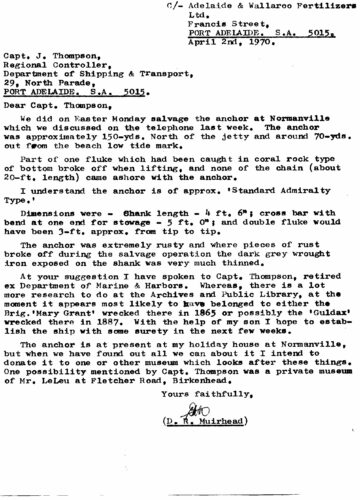
Details of the letter are: –
“2nd April 1970
Dear Capt. J. Thompson,
We did on Easter Monday salvage the anchor at Normanville which was discussed on the telephone last week. The anchor was approximately 150-yds North of the jetty and around 70-yds out from the beach low tide mark.
Part of one fluke which had been caught in coral rock type of bottom broke off when lifting, and none of the chain (about 20-ft length) came ashore with the anchor.
I understand the anchor is of approx. ‘Standard Admiralty Type’.
Dimensions were – Shank Length – 4 ft. 6”; cross bar with bend at one end for stowage – 5ft. 0”; and double fluke would have been 3-ft. approx. from tip to tip.
The anchor was extremely rusty and where pieces of rust broke off during the salvage operation the dark grey wrought iron exposed on the shank was very much thinned.
At your suggestion I have spoken to Capt. Thompson (another, different Capt. Thompson), retired ex Department of Marine & Harbors. Whereas, there is a lot more research to do at the Archives and Public Library, at the moment it appears most likely to have belonged to either the Brig ‘Mary Grant’ wrecked there in 1865 or possibly the ‘Guldax’ wrecked there in 1887. With the help of my son I hope to establish the ship with some surety in the next few weeks.
The anchor is at present at my holiday house at Normanville, but when we have found out all we can about it I intend to donate it to one or other museum which looks after these things. One possibility mentioned by Capt. Thompson was a private museum of Mr Le Leu at Fletcher Road, Birkenhead.
Yours faithfully, D.R. Muirhead”
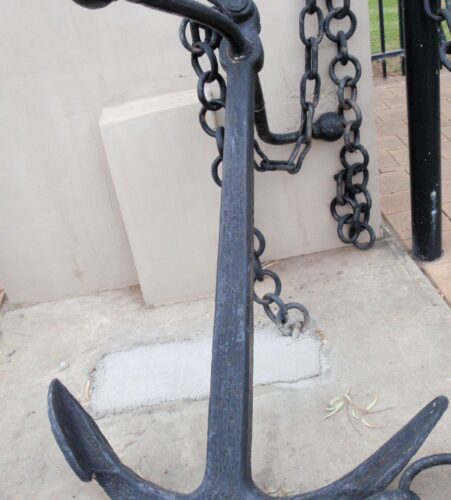
An anchor of similar style and size to the one recovered from Normanville in 1970
I could not recall ever hearing of the brig ‘Mary Grant’ at all, never mind word of it being wrecked at Normanville, or anywhere in South Australia. After doing a little research on the vessel, I made enquiries via Facebook: –
“Does anyone know anything about any SA connections for a brig called Mary Grant which may have lost an anchor at Normanville in 1865? An Admiralty anchor recovered in 1970 had a shank 4’6″ long, flukes 3′ from “tip to tip” and stock 5′ long.”
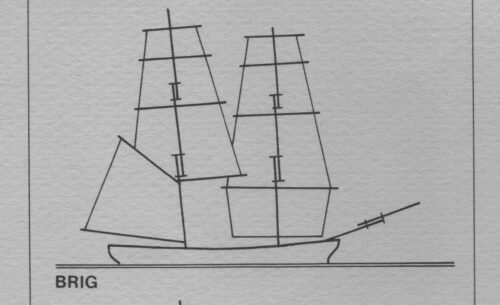
A simple diagram of a brig
(Source: “Conserving Our Historic Shipwrecks”, SA Dept. Env. & Planning, 1983)
Chris Lewczak responded by saying, “Apparently wrecked on the beach after its anchor fouled when at Yankalilla” and giving a link to Trove where I found the following report on the incident: –
“Empire (Sydney, NSW: 1850 – 1875) Mon 13 Nov 1865, Page 4 –
WRECK OF THE MARY GRANT AT YANKALILLA.
The River Don correspondent of The Launceston Examiner says: –
“Through the courtesy of Captain Anderson, of the schooner Walrus, I am able to place before your readers the particulars of the wreck of the Mary Grant, from the River Don: –
The brig Mary Grant, (?) from Adelaide to Melbourne, put in at Yankalilla on Wednesday, 20th September, for the purpose of shipping flour, &c, for Melbourne, from Mr. Ferguson’s warehouse. The loading was completed, and the Custom house officer had cleared her on Friday. On Saturday afternoon she attempted to put out to sea by letting her sails, &c, but the captain found that her anchor was foul of the moorings. During the time which elapsed, the wind, which had been fresh, increased to a perfect gale, and fears were entertained for her safety. As the evening drew on, it was seen that she had dragged her anchor, and was evidently being driven on shore. Mr. Williams, the harbour master, Mr. Butterworth, and some other gentlemen immediately lit fires on the beach, and burnt blue lights as signals to the captain that he was to avoid a very dangerous reef about one mile northward from the jetty, to which, as the wind changed a little to the southward, she was fast approaching. Messengers were also sent to the village for assistance, as there being women and children on board loss of life was anticipated. Some twenty or thirty men Immediately went down to the spot, and the women and children were put over-board one at a time, and rescued by those who had gone into the water to their assistance. Mr. Butterworth, in the most humane manner, directed that the poor sufferers, who were half dead with fright and exposure to the cold and wet, should be taken to his house and looked after, which was done; and at about one in the morning the vessel came broad side on to tbs beach about half way between the rocks and the jetty. The sea had been for some time breaking over her, and the captain and crew were glad to take shelter for some time at the Normanville Hotel, where the kind-hearted hostess did everything in her power to administer to their comfort. All day on Sunday the cargo was being removed; but as there was a depth of two feet six inches of muddy water in the hold, and two tiers of wheat bags were saturated. I am afraid a large portion of it will be entirely spoilt. Great praise is due to Messrs. Williams, Moore. Butterworth, Fergusson, and the men of the neighbourhood generally, for their exertions in endeavouring to save life and property. It is feared that she will hardly be able to put to sea again, as she is very much strained and injured.
Noon, Monday. – No hopes of saving her.
Yankalilla, September 27.
The Mary Grant still lies on the beach awaiting the decision of the Marine Inspectors, who will be here today. Doubts are expressed as to whether the expense of removing her will not amount to more than her value.”
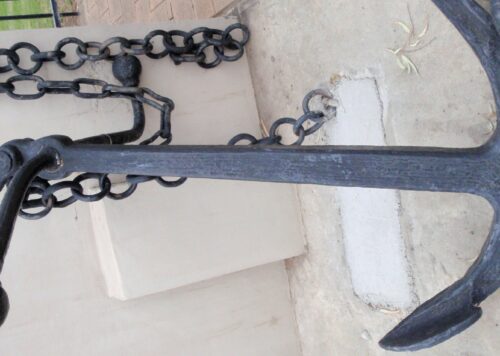
An anchor of similar style and size to the one recovered from Normanville in 1970
According to the web page found at https://www.environment.gov.au/shipwreck/public/wreck/wreck.do?key=5992 , “Warrnambool Examiner 1868: The schooner Balmoral and the brig Mary Grant were anchored full of cargo, and waiting for a wind to get away. They both commenced dragging their anchors when it came on to blow, and by half-past eight in the morning both vessels were ashore, the sea running in very high and making a clean breach over both of them.”
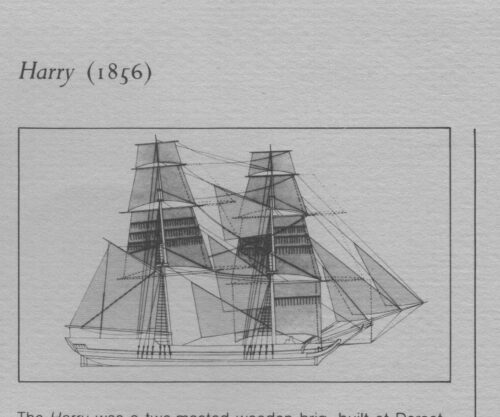
The Harry, shipwrecked in Horseshoe Bay, was a brig similar to the Mary Grant
(Source: “Conserving Our Historic Shipwrecks”, SA Dept. Env. & Planning, 1983)
According to the web page found at http://oceans1.customer.netspace.net.au/vic-wrecks.html, “Mary Grant. Brig, 166 tons*. Built 1850. Wrecked near Newcastle 1878. [LPA** – also lists as schooner]. On 9 July 1868, stranded at Port Fairy, Victoria, 1868. Re-floated on next full tide.”
*(Different sources suggest different tonnage)
**(“Ships and Shipwrecks at Port Albert” by Jack Loney)
The above details suggest that the brig Mary Grant was grounded at Normanville, South Australia in September 1865, stranded at Port Fairy, Victoria in 1868 and finally(?) wrecked near Newcastle, NSW in 1878. So, as long as it is the same vessel being discussed throughout, the Mary Grant was apparently re-floated at Normanville in 1865. This would account for there being no reference to a shipwreck of that name in South Australia.
Adrian Brown later suggested the following details: –
“If you were interested, and I don’t know the story, a look at the records of the Marine Board might tell something of the story if there was an enquiry for instance it may detail the events of the stranding, in trying to find out what happened, and this might say the type of anchor which was lost. There are rules for the numbers and sizes of anchors for vessels, dependent on the ships size. With some research you might find the Lloyds survey of the original build, this will detail, in some way, anchors. If you take the ships tonnage, and the anchors dimensions, it should be possible to begin to say if that anchor might belong to that ship.
“Sometimes anchors are lost without the loss being recorded, or some smaller anchors were placed for moorings. They would typically have the upward facing fluke removed/bent back for safety.”
I am now on the lookout for an Admiralty anchor around Port Adelaide with a shank 4’6″ (1370mm) long, a stock 5′ (1500mm) long and one fluke missing.
(My thanks go to Adrian Brown and Chris Lewczak for their assistance in the above details.)
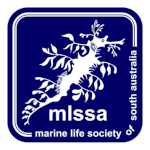
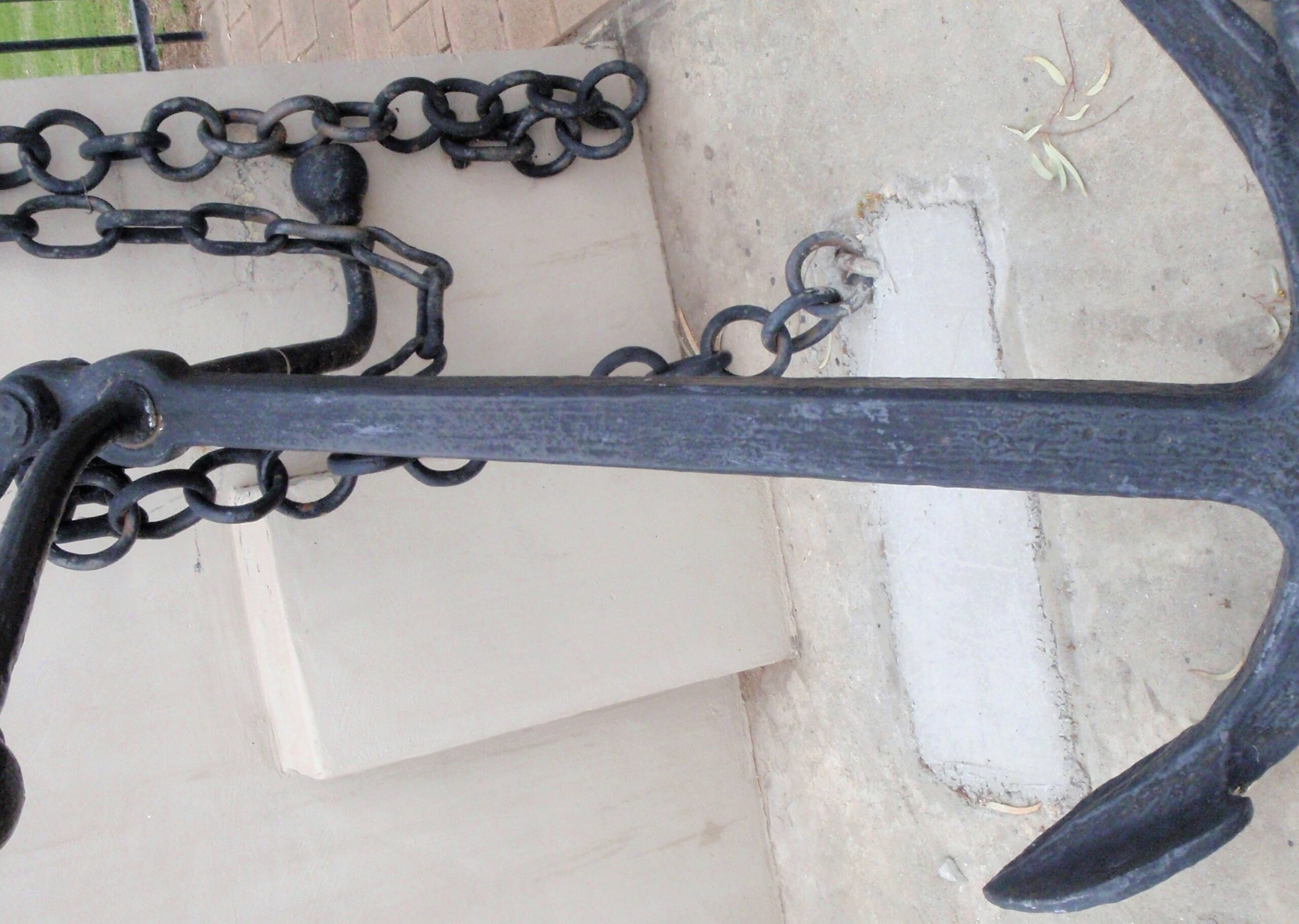
Thanks Steve, closure for me and my late father.
I’m confident the anchor is the one abandoned by the successfully refloated Mary Grant.